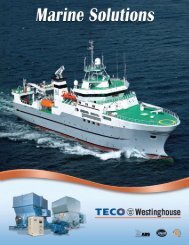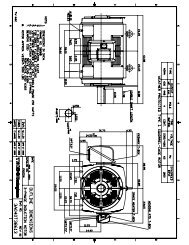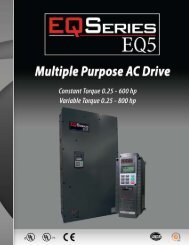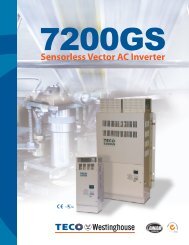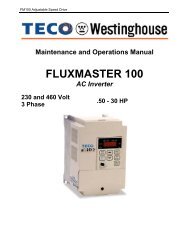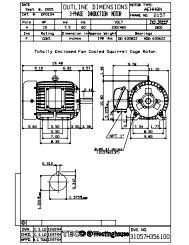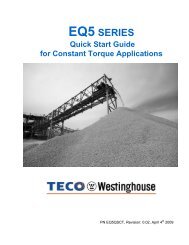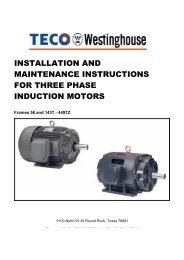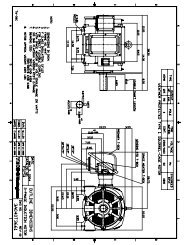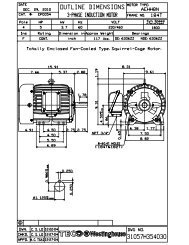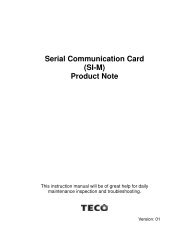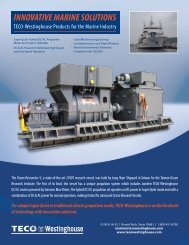EQ7 Series Instruction Manual - TECO-Westinghouse Motor Company
EQ7 Series Instruction Manual - TECO-Westinghouse Motor Company
EQ7 Series Instruction Manual - TECO-Westinghouse Motor Company
Create successful ePaper yourself
Turn your PDF publications into a flip-book with our unique Google optimized e-Paper software.
[ 7 ] Heat sink overheat<br />
Problem Temperature around heat sink has risen abnormally.<br />
Possible Causes<br />
(1) Temperature around the<br />
inverter exceeded the<br />
inverter's specification<br />
range.<br />
What to Check and Suggested Measures<br />
Measure the temperature around the inverter.<br />
Lower the temperature around the inverter (e.g., ventilate the panel where the<br />
inverter is mounted).<br />
(2) Ventilation path is blocked. Check if there is sufficient clearance around the inverter.<br />
Change the mounting place to ensure the clearance.<br />
(3) Cooling fan's airflow volume<br />
decreased due to the<br />
service life expired or failure.<br />
Check if the heat sink is not clogged.<br />
Clean the heat sink.<br />
Check the cumulative run time of the cooling fan. Refer to Chapter 3, Section<br />
3.4.6 "Reading maintenance information – Menu #5 "Maintenance Information"."<br />
Replace the cooling fan.<br />
Visually check whether the cooling fan rotates normally.<br />
Replace the cooling fan.<br />
Inverters of 60 HP or above for three-phase 230 V series and those of 125 HP or<br />
above for three-phase 460 V series are equipped with not only a cooling fan for<br />
heat sink but also an internal air circulation fan. Check the following.<br />
Check the connection of the fan power switching connectors "CN R" and<br />
"CN W."<br />
Correct the connection. (Refer to " Switching connectors" in Chapter 2,<br />
Section 2.3.4 "Wiring of main circuit terminals and grounding terminals".<br />
(4) Overload. Measure the output current.<br />
Reduce the load (e.g. Use the heat sink overheat early warning (E01 through<br />
E07) or the overload early warning (E34) and reduce the load before the<br />
overload protection is activated.).<br />
Decrease the motor sound (carrier frequency) (F26).<br />
Enable the overload prevention control (H70).<br />
(5) Running on single-phase<br />
power<br />
[ 8 ] External alarm<br />
Refer to Section 10.7 "If the Inverter is Running on Single-Phase Power, [ 1 ]<br />
and [ 6 ].<br />
Problem External alarm was inputted (THR).<br />
(when the "Enable external alarm trip" THR has been assigned to any of digital input terminals)<br />
Possible Causes<br />
(1) An alarm function of external<br />
equipment was activated.<br />
(2) Wrong connection or poor<br />
contact in external alarm<br />
signal wiring.<br />
(3) Incorrect setting of function<br />
code data.<br />
[ 9 ] Inverter internal overheat<br />
What to Check and Suggested Measures<br />
Check the operation of external equipment.<br />
Remove the cause of the alarm that occurred.<br />
Check if the external alarm signal wiring is correctly connected to the terminal to<br />
which the "Enable external alarm trip" terminal command THR has been<br />
assigned (Any of E01 through E07, E98, and E99 should be set to "9.").<br />
Connect the external alarm signal wire correctly.<br />
Check whether the "Enable external alarm trip" terminal command THR has<br />
been assigned to an unavailable terminal (with E01 through E07, E98, or E99).<br />
Correct the assignment.<br />
Check whether the normal/negative logic of the external signal matches that of<br />
the THR command specified by any of E01 through E07, E98, and E99.<br />
Ensure the matching of the normal/negative logic.<br />
Problem Temperature inside the inverter has exceeded the allowable limit.<br />
Possible Causes<br />
(1) The surrounding<br />
temperature exceeded the<br />
inverter's specification limit.<br />
(2) Running on single-phase<br />
power<br />
What to Check and Suggested Measures<br />
Measure the surrounding temperature.<br />
Lower the temperature around the inverter (e.g., ventilate the panel where<br />
the inverter is mounted).<br />
Refer to Section 10.7 "If the Inverter is Running on Single-Phase Power," [ 6 ].<br />
10-15



